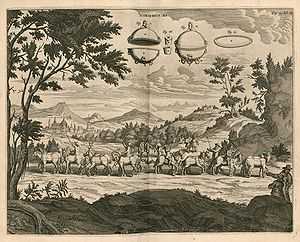Gaspar Schott
| Society of Jesus | |
History of the Jesuits | |
Gaspar Schott (5 February 1608 – 22 May 1666) (in German Kaspar Schott, in Latin Gaspare Schotto) was a German Jesuit and scientist, specializing in the fields of physics, mathematics and natural philosophy, and known for his industry.
Biography
He was born at Bad Königshofen im Grabfeld. It is probable, but not certain, that his early education was at the Jesuit College at Würzburg. In any case, at the age of 19 he joined the Society of Jesus, entering the novitiate at Trier on October 30th 1627. After two years of novitiate training, he matriculated at the University of Würzburg on November 6th 1629 to begin a three year study of Philosophy, following the normal academic path prescribed for Jesuit seminarians. Owing to the Swedish invasion of Würzburg in October 1631, the Jesuit community fled the city. Schott went, first to the Jesuit seminary of Tournai in Belgium, and subsequently, in 1633, to Caltagirone in Sicily, where he continued his study of Theology. After two years at Caltagirone, he was transferred to Palermo for his final year study of Theology after which, in 1637, he was ordained a priest. For the next fifteen years he held a range of teaching and pastoral positions in various Jesuit colleges in Sicily. In 1652, following correspondence with his old mathematics teacher at Würzburg, Fr. Athanasius Kircher, now an internationally acclaimed scholar at the Collegio Romano, Schott was transferred to the Collegio to work as Kircher's assistant. He was to spend the next two and a half years assisting Kircher, but also assembling material of his own for which he would later seek a publisher. In 1655 Schott returned to Germany, first to Mainz,and later the same year to Wurzburg where he was to remain for the rest of his life. His return to Germany appears to have been partly motivated by the desire of his Jesuit superiors to mollify the Archbishop Elector of Mainz, Johann von Schönborn, with whom relations had been strained.
Works

Schott was the author of numerous works from the fields of mathematics, physics, and magic. However, those works were mostly a compilations of reports, articles or books he read and his own repeated experiments; he has done little, if any, original research.
Schott is most widely known for his works on hydraulic and mechanical instruments. His treatise on "chronometric marvels" is the first work describing a universal joint and providing the classification of gear teeth.
Among his most famous works is the book Magia universalis naturæ et artis (4 vols., Würtzburg, 1657–1659), filled with many mathematical problems and physical experiments, mostly from the areas of optics and acoustics. His Mechanicahydraulica-pneumatica (Würtzburg, 1657) contains the first description of von Guericke's air pump. He also published Pantometricum Kircherianum (Würtzburg, 1660); Physica curiosa (Würtzburg, 1662), a supplement to the Magia universalis; Anatomia physico-hydrostatica fontium et fluminum (Würtzburg, 1663), "Organum Mathematicum" (1668) and several editions of a Cursus mathematicus. He was also the editor of the Itinerarium extacticum of Athanasius Kircher and the Amussis Ferdidindea of Albert Curtz.
External links
- Catholic Encyclopedia
- Data from Galileo Project
- Biography in German
- Schott's Mechanica hydraulico-pneumatica. Pars I, 1657
- Kircher/Schott: Athanasii Kircheri iter extaticum coeleste, 1660
- Kircher/Schott: Pantometrum Kircherianum, hoc est, instrumentum geometricum novem, 1660
- Physica Curiosa., 1607
See also
- List of Jesuit scientists
- List of Roman Catholic scientist-clerics
|
